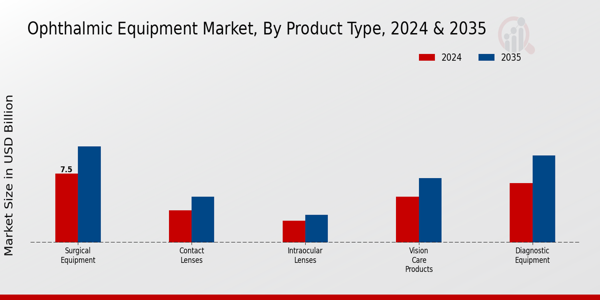Ophthalmic Equipment Market Product Type Insights
The Ophthalmic Equipment Market segmentation by Product Type showcases a comprehensive landscape of varied offerings poised to cater to the eye care domain. By 2024, the Diagnostic Equipment segment is valued at 6.5 USD Billion, reflecting a substantial demand for technologies that enhance the precision of eye examinations, which is critical for early detection and treatment of ocular diseases.
Surgical Equipment represents another strong area, with a valuation of 7.5 USD Billion in 2024, driven by advancements in surgical techniques and an increasing prevalence of eye surgeries globally.This segment is particularly significant, as it not only facilitates better patient outcomes but also pushes innovation in minimally invasive procedures. Vision Care Products account for a market value of 5.0 USD billion in 2024, underlining the growing need for corrective solutions amid rising numbers of individuals experiencing vision problems.
The Contact Lenses segment, valued at 3.5 USD Billion in 2024, is seeing enhanced consumer acceptance owing to the convenience and comfort they provide, which is further reflected in a trend toward daily disposable options.Lastly, Intraocular Lenses are valued at 2.37 USD Billion in 2024, playing a critical role in cataract surgeries, which are common procedures performed worldwide. As cataract incidence rises, so does the demand for this product type, demonstrating its increasing significance in the realm of surgical treatments.
Each of these segments contributes uniquely to the Ophthalmic Equipment Market revenue, facilitating enhanced patient care and addressing the diverse needs of eye health on a global scale.
With the anticipated trends in healthcare technology, including the integration of artificial intelligence and telemedicine, the growth in various product types is expected to further advance, presenting promising opportunities for innovation and market expansion.

Source: Primary Research, Secondary Research, Market Research Future Database, and Analyst Review
Ophthalmic Equipment Market Application Insights
The Ophthalmic Equipment Market, valued at 24.87 USD Billion in 2024, explores a diverse Application segment that includes Cataract Surgery, Retinal Surgery, Glaucoma Surgery, and Refractive Surgery. Each of these applications plays a critical role in enhancing patient outcomes and addressing prevalent eye disorders. Cataract Surgery stands out as a leading procedure, driven by the increasing global prevalence of cataracts, particularly among the aging population.
Retinal Surgery continues to gain traction due to rising incidences of retinal diseases, while Glaucoma Surgery is significant in managing one of the leading causes of blindness worldwide.Refractive Surgery, with advancements in laser technology, has transformed vision correction, attracting patients seeking reduced dependency on glasses or contact lenses. The overall Ophthalmic Equipment Market revenue is bolstered by these applications, highlighting their importance in the healthcare industry. As the market evolves, innovations and technological advancements will continue to drive growth, with the forecast revealing an expected understanding of market dynamics until 2035 and the future market growth prospects.
Ophthalmic Equipment Market End Use Insights
The Ophthalmic Equipment Market is expected to experience significant growth, notably with its revenue projected to reach 24.87 USD billion by 2024. Within this market, the End Use segment showcases a diverse range of healthcare facilities, including Hospitals, Ophthalmology Clinics, Research Laboratories, and Eye Care Centers, each playing a crucial role in delivering specialized eye care services. Hospitals represent a major proportion in this segment, as they provide comprehensive ocular diagnosis and surgical treatments.
Ophthalmology Clinics focus on specialized care, making them vital for routine check-ups and advanced procedures.Research Laboratories contribute significantly by advancing innovation in ophthalmic technologies and treatments, reflecting the essential role of Research and Development in the industry. Eye Care Centers cater to the increasing consumer demand for accessible eye care services, thus bouncing back strongly after recent challenges. The market growth in this segment is driven by a rising prevalence of eye-related disorders and an increasing geriatric population globally.
As advancements in ophthalmic technologies continue to emerge, opportunities for further development and investment in these areas become evident.The overall dynamics and Ophthalmic Equipment Market data reflect a robust industry poised for sustained growth.
Ophthalmic Equipment Market Technology Insights
The Technology segment of the Ophthalmic Equipment Market is a vital component of the industry, driven by advancements aimed at improving patient outcomes and diagnostic accuracy. By 2024, the overall market value is expected to reach 24.87 USD billion, reflecting increasing demand for innovative ophthalmic solutions. Prominent technologies include Laser Technology, Optical Coherence Tomography, Ultrasound Technology, and Phacoemulsification, each playing a crucial role in eye care. Laser Technology is particularly significant due to its precision in treating various eye conditions, enhancing treatment efficiency.Optical Coherence Tomography has revolutionized imaging in ophthalmology, allowing in-depth visualization of the retina and anterior segment.
Ultrasound Technology provides essential diagnostic capabilities, particularly in assessing ocular structures. Phacoemulsification remains a dominant technique for cataract surgeries, epitomizing minimal invasiveness and quick recovery for patients. The collective advancements in these technologies not only propel the Ophthalmic Equipment Market revenue but also foster enhanced patient experiences and outcomes across the globe.Challenges such as the high cost of equipment and stringent regulatory requirements present hurdles, while opportunities for growth exist in developing regions where access to eye care is improving. Robust funding for Research and Development initiatives further supports technological innovations, ensuring the sector's sustained progress.











